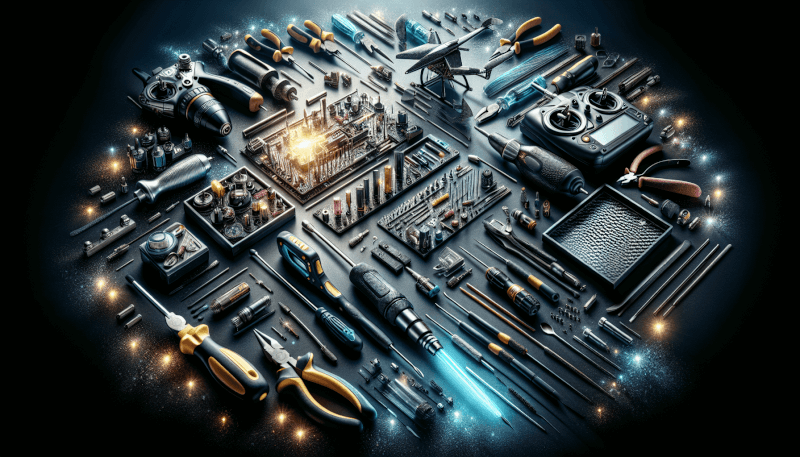Whether you’re a seasoned hobbyist or just starting out, building your own RC helicopter can be a rewarding and exciting endeavor. However, to ensure that your project is successful, it’s important to have the right tools and equipment at your disposal. From screwdrivers and pliers to a trusty soldering iron, this article will guide you through the essential items you’ll need to bring your DIY RC helicopter to life. So grab your toolbox and let’s get started on this thrilling journey of remote-controlled aviation!

1. Soldering Iron
When it comes to building your own RC helicopter, a soldering iron is an essential tool that should not be overlooked. The soldering iron allows you to connect different components together, ensuring a secure and reliable electrical connection. There are a few key features to consider when choosing a soldering iron for your RC helicopter-building journey.
Adjustable Temperature Control
One important feature to look for in a soldering iron is adjustable temperature control. Different soldering tasks require different temperatures, and having the ability to adjust the temperature of your soldering iron ensures that you can work with a wide range of materials without damaging them. Whether you’re soldering delicate wires or heavier components, having control over the temperature allows for more precise and efficient soldering.
Fine Tip
Another crucial aspect of a soldering iron is the type of tip it has. For working on small and intricate RC helicopter components, a soldering iron with a fine tip is highly recommended. A fine tip allows you to accurately and easily maneuver around small soldering points, providing you with greater control and precision.
Soldering Stand
To ensure safety and convenience during your RC helicopter-building process, it is essential to have a soldering stand. This stand holds your soldering iron when it’s not in use, preventing accidental burns or damage to your work surface. Additionally, a soldering stand often includes a sponge or brass wool for cleaning the soldering iron tip, ensuring optimal performance and longevity of the tool.
Soldering Wire
Soldering wire is the material that fuses together various electrical components in your RC helicopter. It is crucial to choose high-quality soldering wire that melts easily and forms strong connections. Look for soldering wire with flux in the core, as it helps to remove oxidation and promote better soldering results.
Soldering Flux
In order to achieve clean and reliable solder joints, soldering flux is an essential addition to your RC helicopter-building toolkit. Flux promotes efficient heat transfer and aids in the removal of oxide layers from metal surfaces, ensuring a stronger and more durable solder joint. It is recommended to use a no-clean flux, as it eliminates the need for additional cleaning after soldering.
2. Screwdriver Set
A versatile and comprehensive screwdriver set is an indispensable tool for any RC helicopter building project. It allows you to tighten and loosen screws of various sizes and types, ensuring that all components are securely fastened together. Here are some key features to consider when selecting a screwdriver set for your DIY RC helicopter venture.
Various Sizes (Flathead, Phillips, Hex)
RC helicopters come with a multitude of screws, each requiring a specific driver type. A screwdriver set with various sizes and types of bits, including flathead, Phillips, and hex, ensures that you have the right tool for every screw you encounter. Whether you need to tighten a small screw on a delicate component or tackle a larger and more stubborn screw, having a wide selection of screwdriver bits at your disposal is essential for smooth and efficient building.
Magnetic Tips
One feature that can greatly enhance your RC helicopter building experience is the inclusion of magnetic tips on your screwdriver set. Magnetic screwdriver tips securely hold screws in place, allowing for easier insertion and extraction. This feature is especially useful when working in tight and hard-to-reach areas, as it prevents screws from falling and getting lost. Additionally, magnetic tips can save time and frustration when dealing with small screws that are difficult to handle manually.
3. Pliers
Pliers are versatile hand tools that offer a wide range of functionalities during your DIY RC helicopter-building journey. From gripping and holding small components to cutting wires, pliers are a must-have in any hobbyist’s toolkit.
Needle-Nose Pliers
One type of pliers that is particularly useful for RC helicopter building is needle-nose pliers. These pliers have long, slender jaws that taper to a point, allowing you to reach into tight and confined spaces with ease. Needle-nose pliers are ideal for holding small parts, bending wires, and accessing hard-to-reach screws or connectors.
Diagonal Cutters
Diagonal cutters, also known as wire cutters, are an essential tool for trimming and cutting wires during your RC helicopter-building process. These cutters have sharp blades that allow for clean and precise cuts, ensuring that your electrical connections are neat and reliable. Additionally, diagonal cutters can also be used for removing excess plastic or trimming small components.
Long-Nose Pliers
Long-nose pliers, also known as snipe-nose pliers, are another valuable addition to your RC helicopter-building toolkit. These pliers have long, thin jaws with a pointed tip, making them ideal for reaching into tight spaces and gripping small parts. Long-nose pliers are particularly useful when you need to manipulate delicate wires or fasteners that are not easily accessible with other tools.
4. Wire Cutters
Wire cutters are an essential tool when working on any electrical project, including RC helicopter building. They allow you to safely and accurately trim wires to the desired length, ensuring proper electrical connections. It is important to choose wire cutters with the following features for optimal performance.
Sharp Blades
Sharp blades are crucial for clean and precise wire cutting. Dull blades can result in frayed wires or uneven cuts, affecting the overall quality and reliability of your RC helicopter’s electrical connections. Look for wire cutters with hardened steel blades that can easily cut through different gauges of wire while maintaining their sharpness for extended periods of use.
Comfortable Handles
Building an RC helicopter requires attention to detail and precision, which often means spending extended periods of time handling tools. Choosing wire cutters with comfortable handles can significantly enhance your building experience by reducing hand fatigue and providing a better grip. Look for wire cutters with ergonomic handles that are designed to fit comfortably in your hand. Additionally, handles with non-slip grips can provide added control and safety during use.

5. Multimeter
A multimeter is a versatile and essential tool for any DIY RC helicopter builder. It allows you to measure voltage, current, and resistance, enabling you to troubleshoot and diagnose electrical issues effectively. When choosing a multimeter for your RC helicopter-building needs, consider the following features.
Voltage, Current, and Resistance Measurement
A good multimeter should be able to measure voltage, current, and resistance accurately. These measurements are crucial for various aspects of RC helicopter building, from testing battery voltage to troubleshooting faulty electrical components. Make sure the multimeter you choose has a wide range of measurement capabilities to accommodate different electrical systems and components.
Digital Display
A digital display makes it easy to read and interpret the measurements provided by the multimeter. Look for a multimeter with a clear and bright digital display that offers good visibility, even in various lighting conditions. Many modern multimeters also feature backlit displays, which can be particularly useful when working in dimly lit areas or during nighttime builds.
Continuity Test
A continuity test feature in a multimeter allows you to check if a circuit is complete and functioning as intended. It is especially useful for identifying broken wires, loose connections, or faulty components in your RC helicopter. By simply touching the multimeter’s probes together, you can quickly determine if there is a continuous connection or if there is an interruption in the circuit.
6. Heat Gun
A heat gun is a versatile tool that can be extremely useful during the building process of your DIY RC helicopter. It is primarily used for heat-shrinking electrical components, such as heat shrink tubing, to create secure and professional-looking connections. Here are some key features to consider when choosing a heat gun for your RC helicopter-building needs.
Adjustable Temperature Control
Different materials require different levels of heat to achieve optimal results. An adjustable temperature control feature allows you to set the heat gun to the appropriate temperature for your specific application, ensuring that you do not damage the materials or compromise the integrity of your RC helicopter’s electrical connections. Look for a heat gun with a wide temperature range and precise control for maximum versatility.
Variable Airflow
In addition to temperature control, a heat gun with variable airflow settings can also be beneficial. The airflow of a heat gun helps to distribute heat evenly and ensure efficient heat shrinkage. Being able to adjust the airflow allows you to tailor the heat distribution to the specific needs of your RC helicopter-building project, providing better control and more consistent results.
Scraper Nozzle
Some heat guns come with a scraper nozzle attachment, which can be useful for removing paint, decals, or other unwanted materials from your RC helicopter’s components. The scraper nozzle directs a concentrated flow of heat, allowing for effective removal of stubborn or adhesive materials without damaging the underlying surface. Having a scraper nozzle attachment can save you time and effort, especially when refurbishing or customizing your RC helicopter.
Safety Stand
Safety should always be a priority when using a heat gun. Look for a heat gun that comes with a safety stand or holder, which allows you to safely rest the heat gun during breaks or when not in use. A safety stand prevents accidental burns or damage to your work surface, providing peace of mind while working on your RC helicopter-building project.

7. Hex Key Set
A hex key set, also known as Allen wrenches, is a vital tool for RC helicopter building. Hex keys are commonly used to tighten or loosen screws or bolts with hexagonal heads. When selecting a hex key set for your DIY RC helicopter project, consider the following features.
Metric and Imperial Sizes
RC helicopters often feature a combination of metric and imperial screws and bolts. It is essential to choose a hex key set that includes both metric and imperial sizes to ensure compatibility with all the fasteners used in your RC helicopter. Having a complete set ensures that you have the correct size hex key for every screw or bolt, avoiding any potential damage or stripping of the fastener heads.
Ball-End Hex Keys
Ball-end hex keys are designed with a curved or spherical tip that allows for easier insertion into screws or bolts at an angle, making them ideal for hard-to-reach areas. This design feature provides greater flexibility and convenience during your RC helicopter-building process. While standard hex keys can still get the job done, having ball-end hex keys can significantly enhance your ability to access and tighten screws or bolts in confined spaces.
Folding Design
A folding hex key set offers added convenience and portability. By featuring a compact design that folds into a single unit, these sets are easy to carry and store, making them ideal for on-the-go building or for compact workspaces. Additionally, a folding hex key set helps to keep the hex keys organized and prevents them from getting lost or misplaced.
8. Precision Knife Set
A precision knife set is an invaluable tool for various tasks during the RC helicopter-building process. From cutting decals and trimming plastic parts to removing excess glue, a precision knife provides you with the control and precision needed for intricate work. When selecting a precision knife set, consider the following features.
Sharp Blades
Sharp and durable blades are crucial for accurate and clean cutting. Precision knife sets often come with interchangeable blades, allowing you to choose the most appropriate blade type for each task. Look for sets that include blades made from high-quality materials, such as stainless steel or carbon steel, as these blades tend to stay sharp for longer periods of time.
Various Blade Types (Straight, Curved)
Having a variety of blade types allows you to adapt to different cutting needs. Straight blades are ideal for precise and straight cuts, while curved blades provide better maneuverability when working on curved surfaces or for cutting in tight areas. Having a precision knife set that includes both straight and curved blades ensures that you have the right tool for the job, no matter the task at hand.
Ergonomic Handles
Comfort and control are essential when working with precision knives for extended periods. Look for precision knife sets that feature ergonomic handles designed to reduce hand fatigue and provide a secure grip. Handles with textured surfaces or rubberized grips enhance control and stability, allowing for more precise and steady cutting motions.
Safety Caps
Safety should always be a top priority when working with sharp tools. Precision knife sets often come with safety caps for the blades, which protect both the blades themselves and prevent accidental injuries. These safety caps should fit securely over the blades, ensuring that they cannot accidentally come into contact with your hands or other objects when not in use.

9. Battery Charger
A battery charger is an essential tool for any RC helicopter enthusiast. It allows you to recharge the batteries used to power your RC helicopter, ensuring that you have adequate power for your flying adventures. When choosing a battery charger, consider the following features.
Multiple Charging Ports
A charger with multiple charging ports enables you to charge multiple batteries simultaneously, saving you time and ensuring that you have enough power for uninterrupted flying sessions. Look for a charger that can accommodate the specific battery types used in your RC helicopter, whether it’s LiPo, NiMH, or other battery types.
Compatible with Different Battery Types
Different RC helicopters may require different battery types, so it is important to choose a battery charger that is compatible with the specific battery chemistries used in your RC helicopter. Lithium Polymer (LiPo) batteries are commonly used in RC helicopters due to their high energy density, but other battery chemistries like Nickel Metal Hydride (NiMH) or Lithium Iron Phosphate (LiFe) may also be used. Make sure the charger you select can handle the specific chemistry and voltage of the batteries you have.
Safety Features (Overcharging Protection, Temperature Monitoring)
Safety is paramount when it comes to charging batteries. Look for a charger that incorporates safety features such as overcharging protection and temperature monitoring. Overcharging protection prevents your batteries from being charged beyond their safe voltage limits, helping to extend their lifespan and prevent potential hazards. Temperature monitoring ensures that batteries do not overheat during the charging process, reducing the risk of damage or safety issues.
10. Workbench
Having a dedicated workspace is essential for any DIY project, and building an RC helicopter is no exception. A sturdy and well-equipped workbench provides you with the necessary space and organization to efficiently work on your RC helicopter. Here are some key features to consider when setting up your RC helicopter-building workbench.
Sturdy and Stable
A sturdy and stable workbench is vital to ensure a safe and secure building environment. Look for a workbench made from durable materials, such as steel or hardwood, that can support the weight of your RC helicopter and resist vibrations. A workbench with adjustable legs or leveling feet allows you to compensate for uneven floors, ensuring stability during your building process.
Ample Workspace
Having enough workspace is crucial for comfortably assembling and organizing your RC helicopter and its components. Choose a workbench that offers ample tabletop space, allowing you to spread out your tools and parts without feeling cramped or restricted. Additional shelves or compartments can also be beneficial for storing and organizing smaller tools, spare parts, and other accessories.
Tool Storage
A well-organized and easily accessible tool storage system is essential for an efficient and enjoyable building experience. Look for a workbench that includes built-in tool storage options, such as drawers, pegboards, or tool racks. Having designated spaces for your tools ensures that they are within reach whenever you need them, minimizing the time spent searching for specific tools and enhancing your overall productivity.
Built-in Power Outlet
Having access to electricity directly at your workbench can greatly enhance your efficiency and convenience. Look for a workbench that includes a built-in power outlet or has provisions to easily install one. Having a power outlet at your workbench allows you to easily connect your soldering iron, battery charger, or other electric tools without the hassle of extension cords or searching for available power sources.
In conclusion, having the right tools and equipment is essential for a successful DIY RC helicopter-building project. From soldering irons and screwdriver sets to pliers and multimeters, each tool plays a vital role in ensuring the quality and reliability of your RC helicopter. By investing in high-quality tools with the necessary features, you can enhance your building experience and achieve professional-grade results. Remember to always prioritize safety and choose tools that offer comfort, precision, and versatility. With the right tools at your disposal, you’ll be well-equipped to embark on an exciting and rewarding journey of RC helicopter building.



